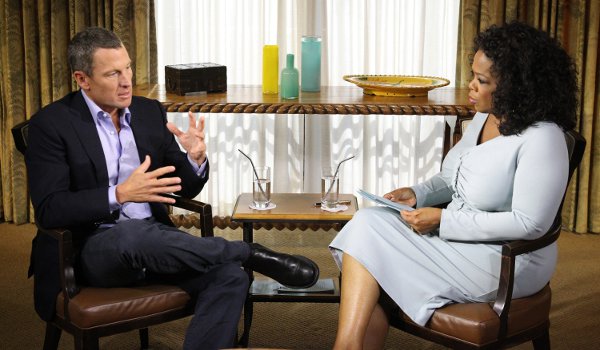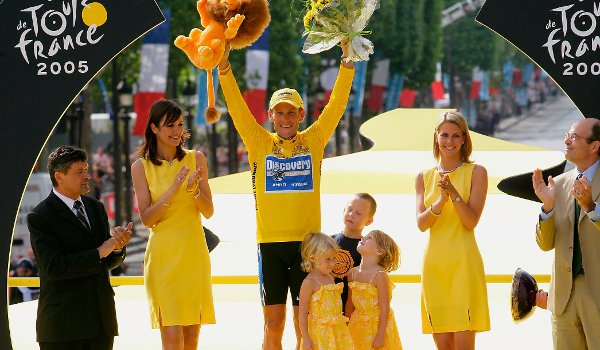The Armstrong Lie
Director: Alex Gibney
★★★★ (Out of 5)
A SIGN of a really bad movie is that you’ve forgotten about it as soon as the lights go up. Good films stay with you longer, force you to think.
By that reckoning The Armstrong Lie is a triumph. A day after viewing, it’s hard to fix the mind on anything else.
Sure, Alex Gibney’s documentary has its flaws, but ultimately it is a fascinating and beautifully shot piece that might not give us all the answers but at least asks the right questions — not just of Armstrong, but of the complicit media and fans who also clung to the fairytale despite the considerable evidence undermining all of the fantastic feats.
What are the flaws? Well, at 123 minutes it’s at least 20 minutes too long and flags in the final quarter. There is no fresh information of note; no scoop. We don’t really get to the core of Armstrong.
Even post disgrace, post-Oprah interview the Texan still seems to be performing instead of giving us the unabridged truth. The mask does not slip.
Expecting Armstrong to suddenly change his spots from a defiant, backs-to-the-wall slugger is naïve though. He has certain qualities that pushed him to the top of a brutal, deeply shady sport and he has them now.
These aggressive, unyielding characteristics helped him recover from advanced cancer. He treated his fight with disease as a sporting battle. Only this time, if he lost, he died. And that, he tells the camera, is his view of defeat ever since: losing equals death.
He didn’t seem to have a much healthier view of defeat pre-cancer either. In footage of him as an angry teenage triathlete Armstrong says, “I just like beating guys.”
You have to see the interview to appreciate the weight behind his words. This isn’t a throwaway line. You know this kid wants to destroy his competition, grind them into the ground.
He never knew his father, which is offered as a part of the reason behind his bottomless well of fury.
The decision to dope came in the early-to-mid 1990s as EPO swept the professional peloton. Armstrong, along with his American cohorts, was getting blown away. Doping was a simple and pragmatic option to him.
Like a lot of sports fans, I’m quite interested in why athletes dope. The idea of altering your physiological make-up, of taking drugs or extracting pints of blood and injecting it in secret during a Tour is horrifying to me.
Like the average fan, though, I am ignorant of extremes. I’ll stand by the side of the road and marvel at the athleticism that powers a man and his bike to the top of a mountain at a speed faster than most could maintain on the flat. But I can’t begin to understand the sacrifice, determination and tolerance for suffering that it takes to get into that condition.
That’s part of the reason why I feel uncomfortable knocking dopers. I find it hard to comprehend their journey but do know that drugs are a small, if essential, part of their success.
Books like the Secret Race by Tyler Hamilton and Daniel Coyle and David Millar’s Racing Through The Dark give a compelling insight (far more so than this film) into the mind of a cheat.
 Lance Armstrong famously admitted to Oprah Winfrey that he doped in all seven of his Tour victories
Lance Armstrong famously admitted to Oprah Winfrey that he doped in all seven of his Tour victoriesHamilton speaks about the 1,000-day rule. Nobody sets out to dope, he says. Most are fervently against it to begin with. Your principles and raw enthusiasm will get you through the first year and the second year.
Come your third season you are tired of hanging out the back of the grupetto on climbs while guys with no more ability than you race for polka dot jerseys. Then there are your employers. They won’t tell you to dope but they won’t renew your contract unless you can get victories or be a capable domestique.
Many cyclists face a stark choice: get on the gear or go home and get another job; treat cycling as a hobby.
There is a line Laurent Fignon used in his autobiography about "doing the job right" (though Fignon maintained his own doping was rare, amateurish; typical of the 1980s era).
He said, “Understand before you pass judgement. But how do you pass judgement once you have understood?”
To hound a cyclist for taking performance enhancing drugs is largely pointless. These guys have been looking for the edge since they first jumped on bikes and pointed them towards Alpine Cols over 100 years ago.
They are apparently clean(er) today. I hope this is true, but would be a fool to wager one cent that it is so.
What set Armstrong apart was the scale, efficiency, ruthlessness and audacity of his doping operation. The film captures this well; scenes with the brilliant but brutally unromantic doctor Michele Ferrari are absorbing.
Then there are the exterior shots on the Tour of an apparently broken down US Postal bus. “The best place to hide is often in plain sight,” comes the wisdom of the Armstrong camp.
Indeed. While the cops and hundreds of fans flap around outside, the riders are doing blood transfusions behind the tinted windows. Armstrong might have had only one testicle at this stage, but it must be the size of a boulder. Who else would run a team that has the nerve to fake a mechanical fault and then bust out the blood bags?
At times like this, the film feels less like a sports documentary and more of a true crime caper, Armstrong as the anti-hero.
At other times, the tale is almost comic. Armstrong’s pious denials are funny and ridiculous with the benefit of hindsight. You almost forget how formidable the lie was until it eventually crumbled.
 Armstrong has been stripped of his Tour victories
Armstrong has been stripped of his Tour victoriesHis strop with the USADA and UCI testers who have shown up at his house simultaneously is also priceless. This is 2009, he says, how can there be no communication? “You guys just look stupid!”
It’s not long before we are reminded again of the seriousness of Armstrong’s transgressions. His most despicable acts are not lying and cheating but his bullying of teammates and rivals and the character assassinations of those that threaten the story — people such as Betsy Andreu and Emma O’Reilly, who he labelled a whore while under oath.
Armstrong’s behaviour has been despicable by any standards of human decency. A lack of empathy and remorse and a sense of infallibility ... he’s certainly displayed sociopathic tendencies. Is he a straight up villain, though? I would argue not.
Some of the reaction to Armstrong since his fall would have you believe he is the worst person on the planet. He is far from it. He cheated, lied, bullied and slandered.
He never killed anyone — in any city in the world there will be a prison full of guys who have. As for the lying, well your nearest parliament will house worse offenders. Bullies who will do or say anything? There’s one in every other office.
Armstrong helped countless thousands of people. Certainly, he used cancer as his shield many times while in combat mode, but the sympathy and compassion he showed to sufferers of the disease comes across as genuine in the film — after what he went through himself, how could it be anything but?
Also, you could never begin to measure the amount of hope he gave to sick people in every part of the world.
They now know his success was a fantasy, but would they rather he didn’t offer this hope?
And to the fans that believed in him for years despite the work of journalists like Paul Kimmage and David Walsh — they must at some point admit to their willingness to look the other way. How badly did they want to delve into the ugly truth? Not as much as they wanted the beautiful lie.
By the climax of the film’s magnificently shot scenes of the 2009 Tour de France, Armstrong is on Mount Ventoux. He’s suffered at the hands of Alberto Contador and the Schleck brothers in previous days.
Now, though, he is matching the young guns stroke for stroke. He’s not just hanging onto the back of them, but peddling alongside, eyeballing them, giving them a full dose of the old indomitable Lance.
Gibney admits that by that stage he was just another fan on the mountain rooting for the old pro. To my shame, I felt myself willing him to stay with the leading group while watching — then the knowledge that he had probably done a transfusion kicked in.
But to many watching at the time, here was a guy who had “never tested positive”. He was 38 and in the process of being worked over by his younger competitors. Then he fixes on them with a look that says “I’ve taken your best shots and I’m still here.” He defied cancer and is now defying time. Even previous sceptics in the French press wrote, “Hats off to the Texan.”
This moment of redemption was set to be the documentary’s climax way back before Gibney and everybody else learnt what really happened.
If you want miracles, read the Bible. If you want to know what happens to men who assume the role of Jesus Christ on a bike then watch this film.
It might not give you the revelations you desire, but it will set the mind racing.

